Battle of Point Pleasant
Introduction
Text-to-speech Audio
Images
The obelisk memorializing the battle at Tu Endie Wei State Park, dedicated in 1909 at the height of the movement to redefine Point Pleasant as a Revolutionary War battle.
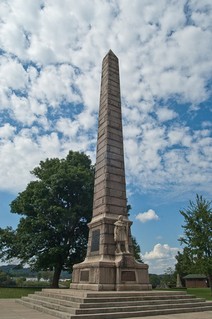
A closer view of the monument's base, which also contains plaques with details of the battle and a list of militiamen killed at the battle.
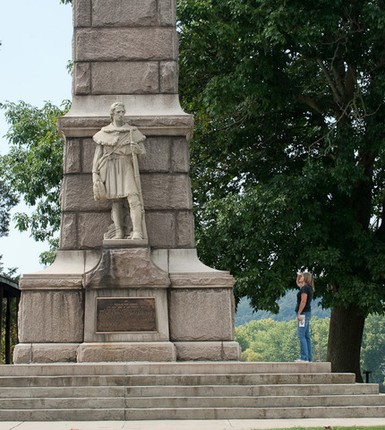
A map of the battlefield and the route of Cornstalk's attack.
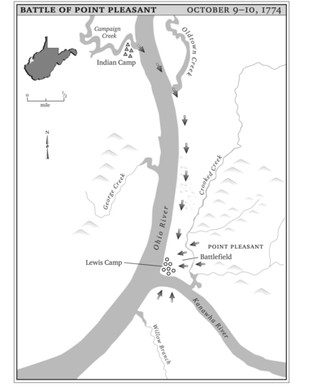


Lord Dunmore, Governor of British Virginia. Highy regarded in English political circles, his career continued well after his ejection from the colonies during the American Revolution. He went on to a post as British Governor of the Bahamas.
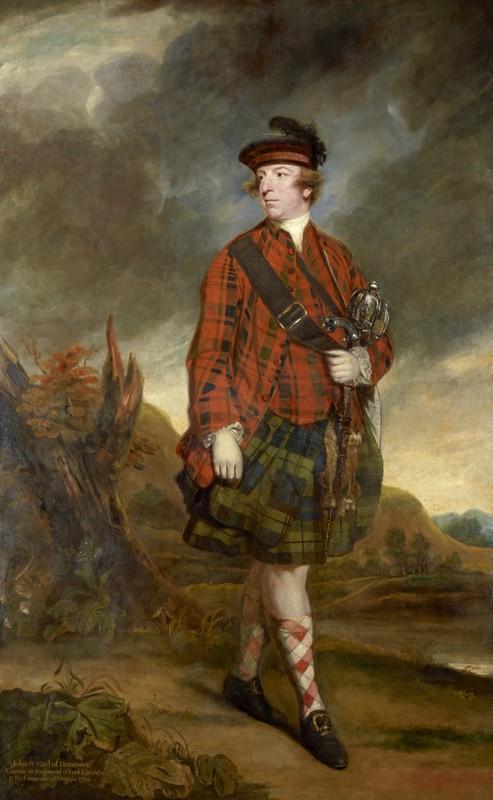
A sculpture at the base of the memorial obelisk depicting a Virginia frontiersman.
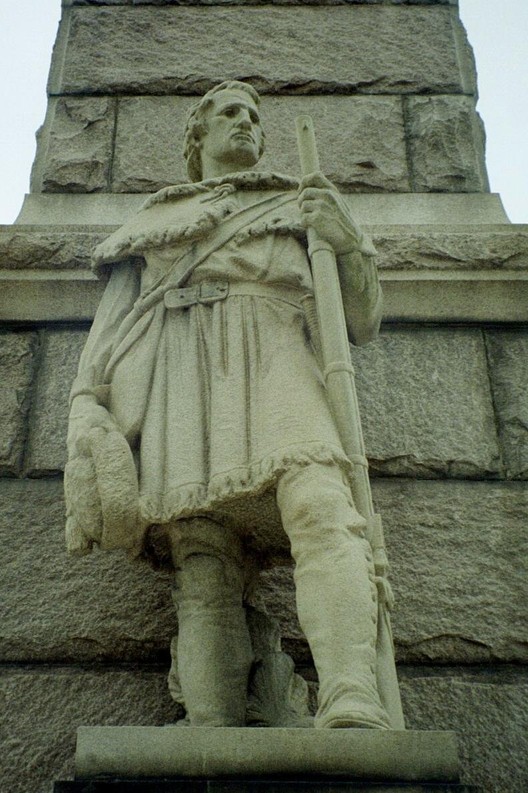
A similarly fanciful painting of Chief Cornstalk. During the American Revolution, Cornstalk traveled back to warn the colonists that Britain was seeking to ally with the Shawnee. Suspicious, the colonists imprisoned him, and he was murderd in 1877.
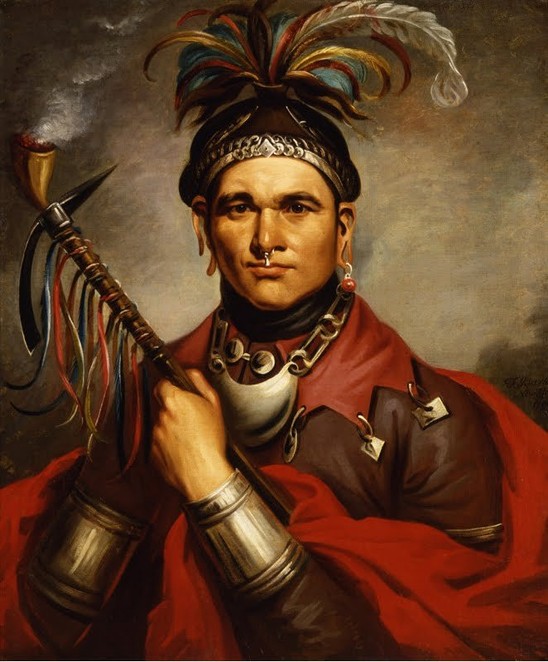
A painting of Shawnee warriors in battle. Many colonists felt the Shawnees were the fiercest and most dangerous of the tribes along the frontier, renowned for bravery in battle. Courtesy of Warfare History Network.
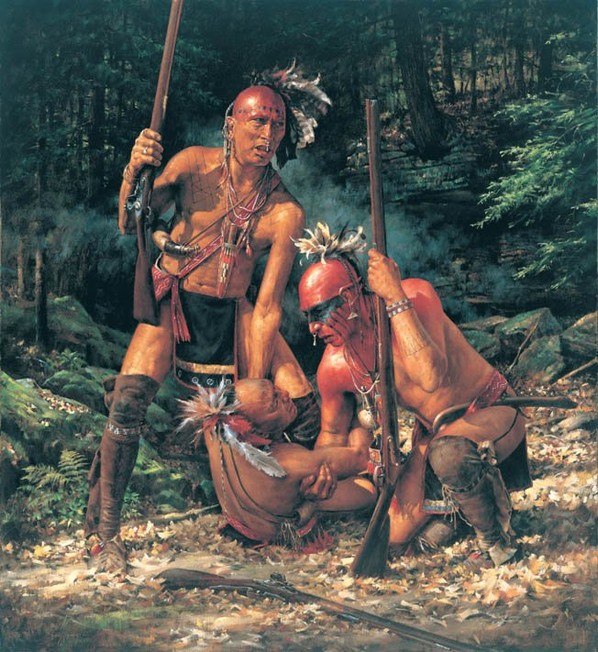
Cornstalk's gravesite at Tu Endie Wei. Cornstalk was widely respected for his leadership and bravery. Some accounts state that he walked backwards during the retreat from Point Pleasant, so that none could say he had ever run from an enemy.

Extract from an interactive map at the online WV Encyclopedia, detailing the routes of Dunmore's troops and several frontier fortifications. The WV Encyclopedia features a number of customizable, interactive maps in their Features section.
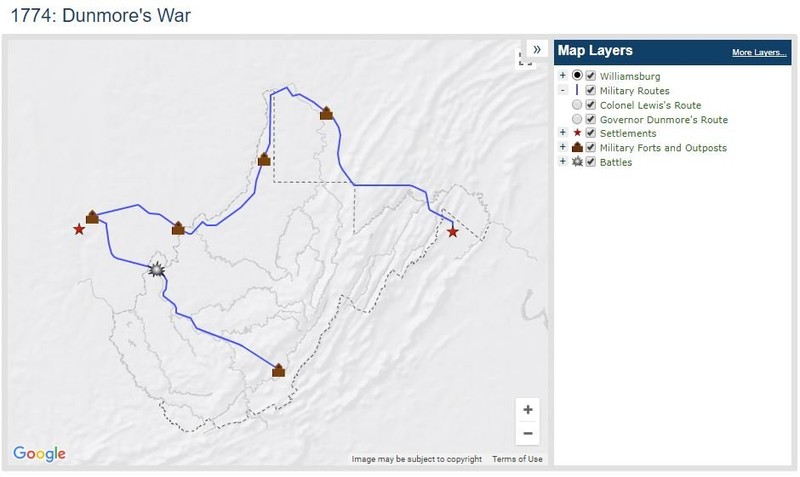
John F. Winkler's detailed book about the battle.
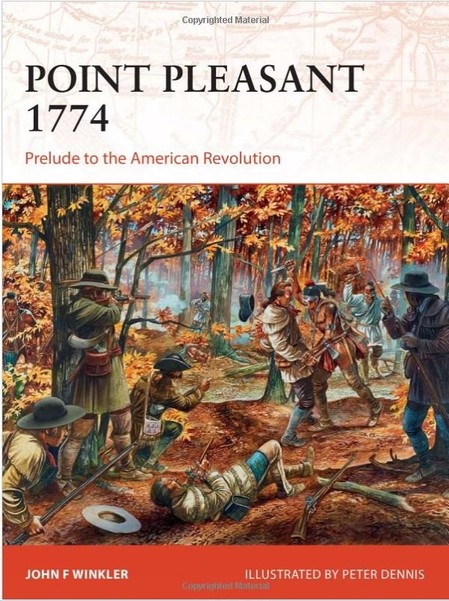
The 1908 Act of Congress designating Point Pleasant as a battle of the American Revolution, which would rank it as the very first, several months before Lexington and Concord. Library of Congress.

Backstory and Context
Text-to-speech Audio
Though the English had emerged victorious in the French and Indian War of 1754-1763 (the North American theater of the Seven Years' War in Europe), ejecting the French hardly secured the frontier from Native American attack. Tension and violence between British colonists and a number of Indian tribes continued all along the colonies' western border.
Unable to police the entirety of the vulnerable territory, British officials became determined to find a diplomatic solution. In 1768, the British government signed the Treaty of Fort Stanwix with the six tribes of the Iroquois Nation, granting the British lands east and south of the Ohio River (effectively adding present-day West Virginia and Kentucky to the colony of Virginia), in hopes that this would provide space for British settlers to expand westward peacefully. For their part, the Iroquois signed away territory for which they had little use or claim--the land in question was primarily a Shawnee hunting ground, and though the Shawnee had representatives present at the treaty's ratification, none were signatories.
Thus, when colonists began to push rapidly across the Allegheny Mountains into the newly acquired territory in West(ern) Virginia, clashes soon began anew with the Shawnee, Delaware, Mingo, and other tribes, who were not part of the Iroquois Confederation and bound in no way by the treaty. The British had, in a manner characteristic of Europeans and their descendants in dealings with Native Americans throughout the westward expansions, failed to make adequate distinctions between tribes. By 1771, this temporary alliance between tribes had solidified into a powerful group labeled by historians as the "Northwestern Confederacy," lead by a Shawnee chief known to the Europeans as Cornstalk (a translation of his Shawnee name, Hokoleskwa). After several particularly bloody raids (sometimes by the Northwestern Confederacy upon white settlers, and just as often by whites upon native villages), including one in which the son of famed American scout Daniel Boone was killed, the colonists called upon Lord Dunmore, British governor of Virginia, to act. Dunmore summarized the situation:
"The Shawnees, Mingoes and some Delawares have fallen on our frontier; killed, scalped, and most cruelly murdered a great many men, women and children. I hope in eight or ten days to march with a body of men over the Allegheny Mountains, and then down the Ohio to the mouth of the Scioto [River in Ohio], and if I can possibly fall upon their towns undiscovered, I think I shall be able to put an end to this most cruel war."8
By September 1774 Dunmore had gathered a militia army of over 1,000 men summoned from Virginia's northwestern counties and commissioned Andrew Lewis as a general of militia with orders to gather a comparable force south of the Alleghenies. Lewis was a respected military leader, having fought extensively in the French and Indian War (alongside George Washington in several instances) and frequently commanded militia troops on the frontier afterward. Quiet, stern, and widely respected, there seems no have been no choice more logical for the southern wing of Dunmore's invasion.
Dunmore had good reason to desire a military victory over the Northwestern Confederacy. Though popular upon his arrival as Governor of Virginia in 1771, his political capital disappeared in 1773 when he dissolved the Virginia House of Burgesses on the claim that they had supported persons opposed to the Crown. Colonial unrest farther north, in Boston, presaged the American Revolution that was to begin only a few months later. Unaware of how soon the powder keg was to blow, Dunmore desired a grand military victory to resurrect his popular support. Additionally, he may have desired to channel colonial unrest into military action against an external threat, rather than allow men of fighting age to dwell on the plight of their fellow colonists farther north.
Dunmore was able to marshal his forces more quickly and set out along the Ohio River, leaving it to Lewis, who had farther to travel with his men, to select where the forces would rendezvous. Lewis departed from his mustering point at Camp Union (present-day Lewisburg) on September 1 with roughly 1,000 men, and a week later wrote to Dunmore that the two divisions would meet at the mouth the "Great Kanawha," where it flows into the Ohio River. A straggling journey of 160 miles over difficult terrain, it took Lewis until September 22 to reach the Elk River in present-day Charleston, West Virginia. There they paused for a week to build a fleet of canoes, by which they crossed the Elk River and continued their march up the Kanawha. They reached their destination on October 6, 1774. There the columnn waited for stragglers, supplies, and their rearguard to catch up, dubbing the place "Camp Pleasant."
Lewis's advance did not go unnoticed. Cornstalk's Shawnee scouts tracked the movement of both Dunmore's and Lewis's divisions. Now that both were within striking distance of Cornstalk's gathering force of warriors near the Shawnee "capital" on the Scioto River (present-day Ohio), the chief was determined to strike before the two divisions could unite. On the night of October 9, a Shawnee force roughly 1,000-strong slipped across the Ohio.
In the pre-dawn hours of October 10, two of Lewis's scouts blundered into the Shawnee advance. One was killed in the headlong flight back to camp, but the remaining scout managed to alert Lewis's men. Not knowing the full extent of the Shawnee attack, Lewis advanced two companies, one commanded by his brother, Colonel Charles Lewis. Both companies were soon hotly engaged with the Shawnee in the thick brush along Crooked Creek, and both company commanders were killed. The colonial skirmishers fell back in disarray toward Camp Pleasant, where they were reinforced by Lewis's main body. A brutal, close quarters fight ensued, with both sides engaged in hand-to-hand combat and close-quarters sniping in the thick timber.
Forced back into the "point" of Camp Pleasant with his left and right flanks anchored on the Ohio and Kanawha Rivers, respectively, Lewis needed a decisive end to the engagement before nightfall. Seeing an opportunity, he detached three companies to slip eastward along the high banks of the Kanawha, past Crooked Creek, then swing back to the west and fall upon the rear of Cornstalk's forces.
The gambit paid off and the Shawnee were taken by surprise. Thinking the attack signaled the arrival of colonial reinforcements, broke off and retreated across the Ohio. They carried most of their dead with them, so the true numbers of Shawnee casualties have never been determined. Lewis, on the other hand, lost nearly one-fifth of his force--75 killed and 140 wounded, among whom were half of his officers. The dead were buried the next day and Lewis crossed the Ohio with the troops he could spare, joining Dunmore a few days later to force the Northern Confederacy at gunpoint to sign a new treaty firmly establishing British sovereignty south and east of the Ohio. Native American "incursions" would not trouble the American frontier for another three years.
Lord Dunmore would be ousted from Virginia early in the American Revolution and was much reviled for the burning of Norfolk.
CONTEXTUAL CONTROVERSY
Rumors that Dunmore treacherously intended to allow the Shawnee to destroy Lewis's division, and may have even aided them in the attempt were rife among Lewis's soldiers. Lewis himself wrote of the possibility, and the timing of Dunmore's invasion appeared highly suspect when fighting broke out at Lexington and Concord soon afterward. Though none of Dunmore's writings and records substantiate the claim, several factions believed that the Governor's operations were intended to deprive Virginia's colonists of fighting men in anticipation of growing unrest against the Crown.
Despite protests from a number of historians that the supposition lacked evidence, a public campaign was fought and won in the early 1900s resulting in the designation of the Battle of Point Pleasant as the first battle of the American Revolution by an Act of Congress in 1908. In the decades since, however, historians in opposition to the perspective have continued to condemn the designation as "manufactured history," and the battle has never assumed the mantle occupied in public memory by Lexington and Concord as "the shot heard round the world."
MEMORIALS
Having not secured the popular association desired (by certain groups) with the Revolution, the Battle of Point Pleasant is commemorated by a West Virginia State Park, not by a National Park. A large obelisk commemorating the battle site stands in Tu Endie Wei State Park, where part of the battlefield is preserved and continues to be celebrated annually in October with Point Pleasant Battle Days. The battlefield is listed in the National Register of Historic Places, and is also the burial place of Cornstalk (with a memorial dedicated to the Shawnee chief) near where he was murdered by white settlers during his imprisonment at Fort Pleasant.
Cite This Entry
Kellison, Phillip et. al. "Battle of Point Pleasant." Clio: Your Guide to History. August 28, 2020. Accessed April 1, 2025. https://theclio.com/tour/1571/4
Sources
1. Lewis, Virgil A.. History of the Battle of Point Pleasant. Charleston, West Virginia. The Tribune Printing Company, 1909.
2. McAllister, J.T.. "The Battle of Point Pleasant." The Virginia Magazine of History and Biography, ser. 1902, vol. 9, no. 4, 395-407. JSTOR.
3. "'Manufactured History:' Re-fighting the Battle of Point Pleasant." West Virginia History, vol. 56, 76-87. Published 1997. WV Archives & History. http://www.wvculture.org/history/journal_wvh/wvh56-5.html
4. Sturm, Philip "Battle of Point Pleasant." e-WV: The West Virginia Encyclopedia. 22 April 2016. Web. 19 January 2018.
5. Lizza, Richard P. "Cornstalk." e-WV: The West Virginia Encyclopedia. 08 October 2012. Web. 21 January 2018.
6. Lord Dunmore's War and the Battle of Point Pleasant. Ohio History Central. Accessed January 20, 2018. http://www.ohiohistorycentral.org/w/Lord_Dunmore%27s_War_and_the_Battle_of_Point_Pleasant.
7. Swisher, James K.. Lord Dunmore’s War: The Battle of Point Pleasant. Warfare History Network. October 26, 2015. Accessed January 20, 2018. http://warfarehistorynetwork.com/daily/military-history/lord-dunmores-war-the-battle-of-point-pleasa....
8. Andrew Lewis. Southwestern Virgina Genealogy Junction. Accessed January 20, 2018. http://www.madeofcotton.com/family/andrew_lewis.html.

